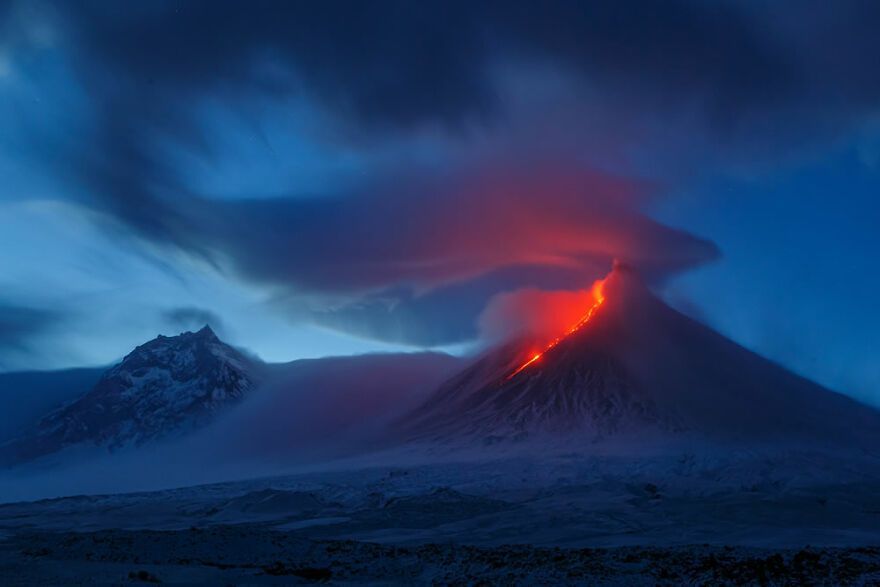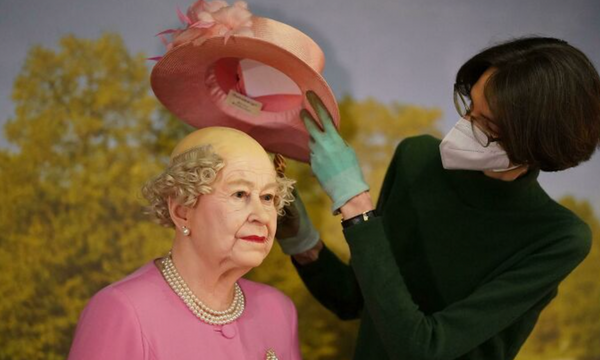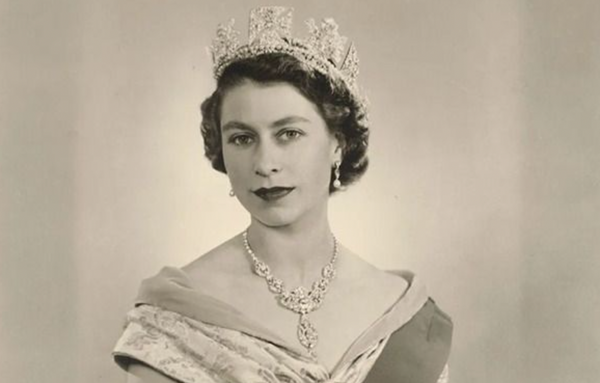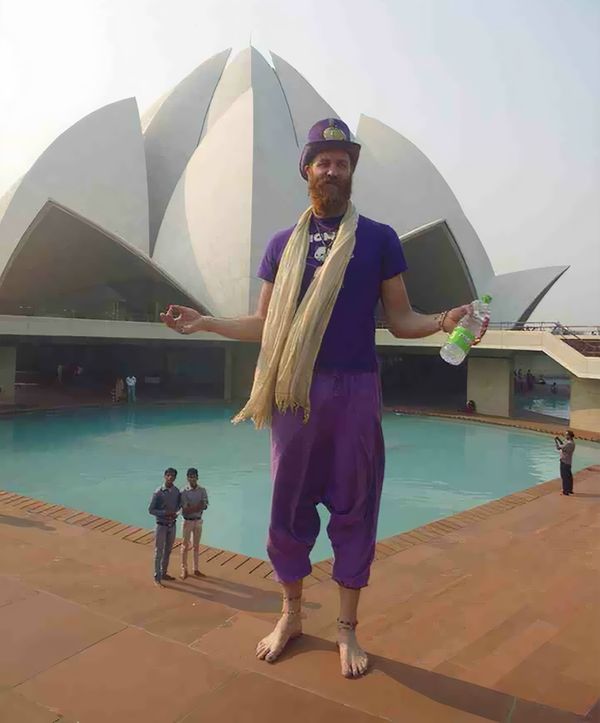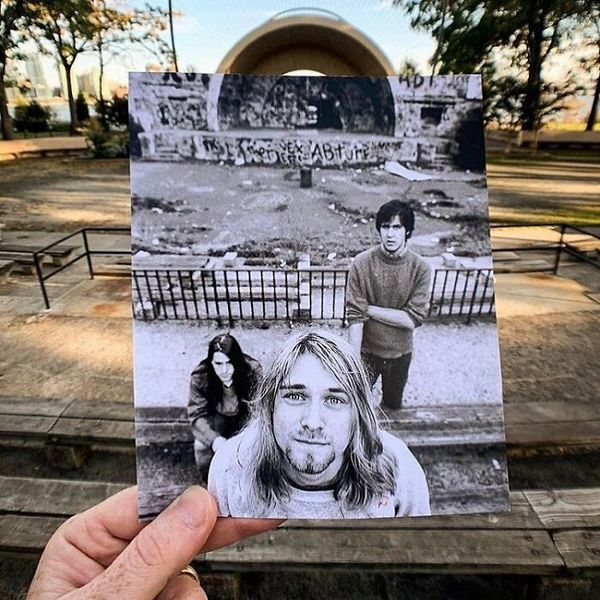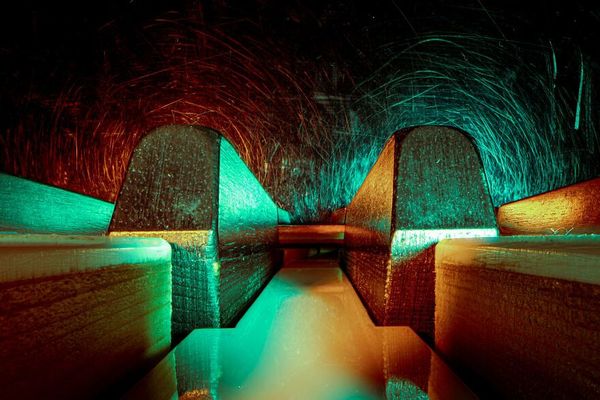Nature never ceases to amaze us. Would you believe that there are people who take pictures for a living and don’t use any filters, editing software, or post-processing? It’s true! These photographers rely on the natural beauty of the scene before them to capture amazing photos.
Have you ever seen an award-winning photograph of nature that just takes your breath away? Photographers who capture the natural world in all its beauty can truly make your heart soar.
In this blog post, we’ll take a look at 30 awe-inspiring images of nature that have won the Nature Photographer of the Year (NPOTY) 2021 awards. From tranquil landscapes to amazing wildlife shots, these photos will leave you feeling refreshed and inspired.
So sit back, relax, and enjoy some stunning photography!
1. Twilight Hunters By Norbert Kovács

Photographer’s Thought: “Near my place of living there is a karst mountain range called Mecsek with numerous sinkholes and caves. During one of my trips into the mountains, I came across this small Dolina. There and then I could see the photo in my mind’s eye.
I usually take photos in springtime before trees start leafing out. I assemble and set the equipment before sunset, take up a position at the mouth of the cave and upon hearing the sound of bats I know they are about to leave their nest to hunt one by one. It is an incredible experience feeling the wind stirred by the flapping of their wings as they fly by me. As the bats begin their hunt, I normally wait for about two hours at the scene because later on their level of activity decreases.
Though I remain invisible to them, they can feel my body temperature when they leave the cave. Some bats are more cautious and return to the caveat first. However, when they realize I do not harm them they also fly out. Since they are an endangered species I only disturb their life cycle for two to three days in spring.
I have observed the individuals of two species so far:
- lesser horseshoe bat (Rhinolophus hipposideros)
- greater horseshoe bat (Rhinolophus ferrumequinum)
The photo was taken from the mouth of a karstic mountain sinkhole. Due to the long exposure time, I placed the camera on a beanbag. The exposure was controlled via a wifi network by using a cell phone. I used a flash for the light source which was set in strobe mode with manual flash.”
2. Slow But Safe By Ruben Perez Novo

Photographer’s Thought: “It occurred to me to take this photo when I found this little snail walking through some dry leaves on the ground. As soon as I saw the semi-transparent shell of the snail I knew that I wanted a strong backlight, the also translucent dry leaves were perfect to help the composition.
I took three leaves from the ground and arranged them with an interesting composition with a flexible clamp. Behind them, I arranged two backlit flashes mounted with a diffuser each. After closing the diaphragm and adjusting the ISO and speed, I adjusted the power and the distance from flashes for good lighting. Finally, I waited until the snail passed in an interesting place for the composition.
The photo was taken on a summer morning in a shady area between some trees. This helped me to be able to use only the light of the flashes for exposure. In this case, the lighting for this photo is exclusively artificial, coming from two flashes which allows you to have total control over the light. I took this photo in Ares – Coruña – Spain.”
3. Leafy Night By Scot Portelli

Photographer’s Thought: “In a Covid year, it has been difficult for many nature photographers to get out in the environment and continue their work. Australia is an amazing place and I think Covid has taught me that I live in one of the most incredible natural places in the world. As a nature photographer, Australia’s coast, deserts, reefs, and rainforests hold a plethora of subject matter to photograph and discover, not to mention the diversity of wildlife above and below the surface. I am passionate about the ocean and its inhabitants, and a lot of my work is centered around the conservation and protection of various marine species. But I am a little obsessed with seadragons. With this image of the endemic leafy seadragon, I wanted to create something that really captured the essence of these delicate vulnerable species which are found only in the southern parts of Australia. The more we understand the ocean and its inhabitants the more people will feel connected and take action to protect our ocean creatures.
It was just after Covid was announced in March 2020, othat ur year-long journey around Australia was interrupted and my wife and I were forced into lockdown for 6 weeks in a small campground on the Fleurieu Peninsula in South Australia. Because we had no fixed address, we were considered refugees and the campground owner allowed us to stay in the campground, which had only one other family for the duration of the lockdown. This ended up being a blessing in disguise, we could still exercise, and diving was allowed. I had the opportunity to dive regularly, becoming familiar with the terrain, and getting to know the dive site, I explored more and more each dive and managed to spot a few individual seadragons that I could easily identify. After several encounters with one specific seadragon, it appeared to be unperturbed by my presence. I was able to compose a shot that tightly captured its eyes, features, and appendages. In the end, I took only one frame when the seadragon turned towards me for just a moment. All the elements aligned and it culminated in the portrait of this beautiful creature.
This photo was taken at dusk and shot with strobes to light the subject as the afternoon light turned into night. The image was shot with a wide fisheye lens with close focus.”
4. Water Lilies Marvelous World By Gaël Modrak

Photographer’s Thought: “Water lilies are a classic source of inspiration for painters and photographers. Discovering them under the surface was a revelation of a few years ago, and it is always a pleasure to go back every summer to that peaceful lake located in the southeast of France. A place where I’m pretty sure to find good conditions to photograph them. There are two species of those land-based flower plants, of which the ancestors returned to the underwater world, present in that area: the European white waterlily (Nymphaea alba) and yellow water-lily (Nuphar lutea). They are not so easy to distinguish, except by the color of their flower floating at the water surface.
Finding the right balance between light, angle of view, and framing depending on the sun position, plant density, and water clarity generally allows a wide variety of images. I approach them by snorkeling and moving very gently, not to create particles from the bottom that would spoil the image quality, and not to get any waves or air bubbles on the surface.
This time I found the right vertical sunlight to get sufficient light, and to observe shadows of the water lilies on the white bottom of the lake, while the light of the flashes restored intense red colors of the lower face of the leaves. The angle of view made the scenic reflection look symmetrical to the surface. And the final touch was obtained thanks to those small freshwater fishes, called red-eyes (Scardinius erythrophtalmus), swimming in front of me while I was holding my breath, waiting for the perfect time to shoot.”
5. Winter Migration By Terje Kolaas

Photographer’s Thought: “I’m privileged enough to have thousands of pink-footed geese literally in my garden several months a year. More than 80,000 make a stopover here in the Trondheim fjord wetland system on their way between the wintering grounds in Denmark and Netherlands and the breeding grounds in Spitsbergen every spring and autumn and the whole scenario is simply spectacular. I have been photographing them for more than 20 years, and at one point I kind of ran out of ideas and got the feeling that «everything» with geese was already done. So what now?!
Thanks to the amazing drone technology the element of air opened up a few years ago, and the wet dream of photographing the geese as being one of them, a part of the flock, up in the air actually became possible. Dozens of failed attempts during the last years, partly because of fragmented landscapes, disturbing buildings, human artifacts, and messy backgrounds. But during the strange and rare events of blizzards and heavy snowfalls in late April 2020, I realized that the photos of my dreams were within reach; photographing the geese from the air against a pure and clean snowy landscape.
I positioned myself close to a field where I knew that the geese would feed regularly and waited for them there. As soon as I heard incoming geese, I took off with the drone and waited for them in the air. Most of the shots did as always have something imperfect to them; like being too far away, being unbalanced, having a wing or a head cut, or some birds overlapping wrong. But this particular one I’m very happy that the jury of the NPOTY 2021 liked it too!”
6. Fox Crossing The Bridge By Andius Teijgeler

Photographer’s Thought: “During the spring period, I went for many evenings to the Amsterdamse Waterleidingduinen to look for foxes and cubs. Due to the frequent visits, we knew a bit more about the behavior of some of the foxes.
This fox has crossed this bridge regularly in the spring. To try to find the right angle for the image I had in mind, we decided to go to a higher point. We had to wait quite a long but decided to stay longer. The light and atmosphere with the ducks in the background were great. At last, we saw the fox on the right side checking if it was safe to cross the bridge. Suddenly she decided to go and I was able to take this shot.”
7. Nature’s Eatable Arctic Gold By Audun Rikardsen

Photographer’s Thought: “Cloudberries are a circumpolar boreal plant, occurring naturally throughout the Northern Hemisphere. In Europe, they grow mostly in the Nordic countries where they are a highly regarded delicacy, often termed the eatable Arctic gold. In earlier times people were protecting their berries in every possible way on their properties and always kept it a secret where they could find them. This is still the case today, but usually in a more civilized way than in previous times…
Despite great demand as a delicacy in the Nordic countries, the cloudberry is not widely cultivated and is primarily a wild plant. In the inland, they are usually found up in the mountains and highlands, but at the coast of Northern Norway, you can find them all the way down to sea level, as here, on a remote island in the Vestfjord close to Lofoten. Because of the light summer nights in the north, you may pick them also at night, like in this picture. I personally love the taste of these berries, my absolute favorite, and they were all eaten after this picture was taken!
There is no other special relevant information about the photo, rather than using two places and a macro wide-angle lens.”
8. Red In Red By Georg Nies

Photographer’s Thought: “Photographing pygmy seahorses is an extremely difficult business. They are very small; rarely larger than 2 centimeters. But above all, they are very well camouflaged and difficult to find in the gorgonians in which they live. Even if you know that a seahorse is living in a gorgonian, does not guarantee that you will find them. Thanks to years of experience and a local dive guide who knows where to find the animals it could be possible. Usually, such an image is created as a joint production. The local dive guide shows the seahorse to the underwater photographer. Because the animals are so tiny and we are talking about image scales of 2:1 or less, the usual way of working is as follows: The dive guide points to the animal with a small metal rod pointer stick. The photographer first looks at the hand of the dive guide and finds the seahorse using the pointer stick as a pathfinder. This requires a good interaction between the photographer and the dive guide.
Unfortunately, many pictures of pygmy seahorses and other curious animals underwater are not taken in a species-appropriate and environmentally friendly way. Tampering with animals and the environment is common practice to get a good picture. For example, the gorgonians are touched over a large area to find the seahorses easier. This causes the individual polyps to withdraw so the pygmies can be found more easily. Such manipulations can be recognized because all the polyps around the seahorse are closed, and other polyps are still open a bit further away.
Moreover, the seahorse likes to turn away from the photographer. Using the pointer stick, they are turned “gently” by the dive guide towards the photographer so that a front portrait is possible. Most importantly, the seahorses do not tolerate too many flashlights. Because they don’t have eyelids, they must endure the amount of light from the flashes. In areas where there are many underwater photographers, these animals go blind within a very short time and do not survive long. Therefore, photos should be reduced to 6 to 8 per photographer.
I would like to take this opportunity to thank the jury for this photo competition very much. By awarding this photo, they show that it is also possible to be awarded a species-appropriate and environmentally friendly underwater photograph.”
9. The King Of The Ocean By Javier Murcia

Photographer’s Thought: “The image shows a juvenile swordfish (Xiphias gladius) inside the labyrinth that forms “the Almadraba”, an ancient fishing art (used since the times of the Romans and Phoenicians) that is currently used to catch large pelagic fish, such as tuna. La Almadraba is located on the southern coast of Spain, in a small fishing village called “La Azohía”. It is the last of the “The Almadrabas” in the Spanish Mediterranean."The Almadraba” is formed by a labyrinth of large nets placed in strategic places where the large fish of the “Scombinados” family pass to reproduce.
It is a very selective and harmless fishing gear where fishermen fight hand in hand with large fish. Every year a diver in fishing gear can capture the work of a man with nature. I like conservation and fish photography.
The swordfish swam tirelessly and, felt cornered, accelerated at high speed and made sharp turns. It is a potentially dangerous species due to its “sword” and size. I could only take about 20 pictures because the animal was very nervous and in danger.”
10. Last Embrace By Roie Galitz

Photographer’s Thought: “A female African elephant has died of natural causes, mainly old age. A pride of lions had found her and enjoyed the big feast. Suddenly, a young lioness, only seven months old, came to the elephant and started working her way around her, moving between the elephant’s front legs in a way that resembles a hug.
One of the things I like about the image, besides the composition and lighting, is the viewer’s experience with the image, which is bipolar. I like to watch people’s reactions to this, when they first respond with “www, they are hugging,” and after a few seconds, they realize that something else is going on. This kind of engagement creates an interesting relationship with the frame.
This image was taken in Tarangire National Park, Tanzania.”
11. Flying Over A Pastel ‘Rainbow’ By Ronald Zimmerman

Photographer’s Thought: “During the autumn migration, many common buzzards (Buteo buteo) can be seen soaring on thermals. In autumn, local common buzzards stay in the country. Common buzzards from Norway and Sweden migrate to the south and south-west of Europe and also to the Netherlands.
Wildlife that allows me to have many photo opportunities are ideal subjects for a creative approach. In 2019 I wanted to move in a different direction. I wanted to add more creativity and more storytelling to my photography. For inspiration, I started reading books about wildlife photography. During the global pandemic, I spent a lot of time experimenting in National Park Zuid-Kennemerland. This national park is my local “laboratory” in the Netherlands to experiment.
In-camera multiple exposures were one of the new techniques I wanted to experiment with. This started with playing and evolved into fresh ideas.
To create this photo, I had to photograph the buzzard, followed by a second, long exposure of the surrounding autumn-colored trees. This different kind of common buzzard image is the result of a yearlong process.”
12. We Are Hanging On The Web By Csaba Daróczi

Photographer’s Thought: “This picture has an interesting and funny story. One afternoon, my wife wanted to go to the store by bike. She hasn’t used her bike in a long time, it’s been in the garage. When she went in there, she came out screaming that her whole bike was covered in spiders, and I had to do something about it. I thought it was a bit of an exaggeration, but of course, I came to help her. Of course, only the spiders were true from the story, there was an egg lump in the bike basket, and that’s where the small spiders were hatched.
I thought it might be a good photo topic, so I suggested she could drive instead of taking the bike. Since it was pretty dark in the garage, I could only take pictures with a flash. I took many pictures of it, but I was not satisfied, there was always something disturbing about the compositions. At some point, the spiders wanted to escape, they released a thread and descended from the basket. That was an interesting scene, and it happened very quickly, but I finally managed to take this picture. By the time my wife got home, the bike was spider-free.”
13. Beautiful World By Levi Fitze

Photographer’s Thought: “A young Alpine Ibex strolls dreamily across an alpine meadow. The flowers in the foreground and the sun breaking through the clouds in the background give this image something unique. It shows the beauty of our nature and the carefree life that this young Ibex is living during the warm summer months. I’ve been following the Alpine Ibex several times into his beautiful habitat in the Swiss Mountains, and I almost always get rewarded with fantastic encounters with these massive animals. As usual, I spent the night in a mountain bivouac to photograph in the morning and evening hours. The situation this evening was just perfect. I was already happy with the nice flowers when suddenly the sun broke through the clouds, and a beautiful backlight situation was created.”
14. Dolphins Home By Dmitry Kokh

Photographer’s Thought: “Sataya Reef (or: Dolphins’ home) in the Red Sea – is one of the best places in the world to swim with wild dolphins. I spent all day with them in the water, and that was for sure one of the best days of my life. You can create thousands of frames at the time of a great encounter. You can shoot an animal from one side, on the other, and on each side. Sometimes you’re so thrilled and hold your finger on a trigger while your camera bursts like a machine gun that makes 20 frames per second. But you always feel that exact moment when you make a very special shot, the one you dreamed of. When everything comes together: the animal’s mood, the light, the color, the depth, and all the rest. And a bit of nature’s magic, maybe. So, this is the one!”
15. Inside A Sequoia By Uge Fuertes

Photographer’s Thought: “The photo was taken at Big Basin Redwoods State Park, in Santa Cruz County, California (USA). This park is the oldest in California, protected since 1902. It is a Sequoia sempervirens forest, with trees that are around 100 meters high and 2000 years old. We were amazed to see it. The tree in the photo is a dry tree attached to the ground by four claws. Numerous fires burned it inside, leaving everything inside it hollow. I visited the place during the day to check the shot from the bottom up. At night we returned to the place, and Opiliones and coyotes entertained and scared us while I took the images. The exposure of this photo is difficult. The part closest to the camera lights up very quickly, but the farthest part (up to 60-80 meters high) stays dark. The use of two-color temperatures in the lighting was decisive for the final result. To be able to frame and illuminate correctly, I took 70 pictures. Only one was perfect. My wife Marta helped me to illuminate the outside of the large trees. It is a very big stage, bigger than it might seem.”
16. Young Wolf (Canis Lupus) By Aare Udras

Photographer’s Thought: “I love nature photos of different species showing their living style in their natural habitat and natural conditions. To see and show it to others, it often needs pretty close wide-angle shots. As photography is all about light, light is a key factor for those shots as well. Also technically, most of the predator’s activity is taking part in dark or totally dark conditions. It is pretty difficult to make such photos, especially of the species that are not very common and are very careful, like the wolves. In Estonia (Europe) there are around 200-300 wolves. Around 100-130 of them are hunted annually.
In my surroundings, the wolf (Canis lupus) is the most intelligent animal, with extremely well-developed senses. They also learned to read and understand human activities and who always have situations under their control. All that makes photographing them a great challenge. I am the happy one, I have seen them.
As I had been looking around for a few years in that area, I knew that the year before, the wolf’s litter was nearby. I started to look for possible bottlenecks on their routes and discovered this small ditch with several beaver dams and a beaver lodge. The beaver is also on the wolf’s menu… I took the chance and installed a camera trap with flashes on the Beaverdam.
In about 6-7 months, I got lucky by getting this picture. This young wolf photographed herself, letting me have a recording. The photo is taken in the eastern part of the Estonian forest area in September at around 4 am. This photo shows well how relaxed the wolf is, even while jogging on the beaver’s dam in absolute darkness. She probably did not find any beaver around, so she returned the same way back in about 7-8 minutes.
Using a camera trap – you are principally trying to create in your mind all the possible situations, and variations and making the compromise to find a suitable site. Choosing focus point, lighting options, settings etcetera in manual mode and hoping something similar happens. The forest is gracious…”
17. The Hand That Feeds By Andrew Upton

Photographer’s Thought: “Down a busy side street in Harajuku, Tokyo, you will find Japan’s most popular otter cafe. Here, three Asian small-clawed otters (Aonyx cinereus) are kept on display in a small glass tank. In this image, a staff member feeds one of the otters a snack of dry pet food. These snacks are high in salt content and unsuited for this species whose natural diet consists of invertebrates like crabs or shellfish, supplemented by fish. According to the IUCN guidelines for the husbandry of Asian small-clawed otters in captivity, the otter’s feed times should be varied as it helps prevent the development of begging or other stereotypic behavior. Hiding food around the enclosure as scatter feeding is also recommended as it promotes the otter’s natural foraging instincts. The limited space and high concentration of otters at Japan’s otter cafés make adequate enrichment difficult. The constant feeding and pampering by guests and staff members have made these otters dependent on human interaction.
I did not feed or handle the animals and spent a long time habituating them to my presence. Once the otters no longer paid attention to me, I was able to become a fly on the wall, documenting the reality of life in this cafe. It was important that I let the otters tell their story in their own time and that my presence did not induce them to “perform” for the camera. Asian small-clawed otters are listed as Vulnerable on the IUCN Red List.”
18. Bluebells And Beeches By Richard Verrone

Photographer’s Thought: “The Bluebells in the Hallerbos in Belgium are my favorite to capture in springtime. Very early on a morning in April, well, it is more like night, I drive from the Netherlands to Belgium and walk into the forest before sunrise. It is still very quiet, and the first birds are already singing. When the sun rises, all the Bluebell flowers and the beech trees' first green leaves will become magical. That is a moment I love very much, every single year!”
19. Yin And Yang By Gheorghe Popa

Photographer’s Thought: “This is a photo I took in the middle of the day and this is an aerial view of Cuejdel lake in winter before the complete frost of the water. Cuejdel is the largest natural dam in Romania, which explains these trees.
The idea came up to me during winter when I observed the lines created by the shades of the trees in the middle of the day over the surface of the lake completely covered with snow. But this time, the lake wasn’t completely covered with ice, which allowed me to obtain this Yin and Yang effect.”
20. The Prow By Andrea Pozzi

Photographer’s Thought: “The Puna is a high desert plateau, where some of the most surreal desert scenery on the planet is found. Here’s the “Campo de Piedra Poméz”, a massive white pumice stone labyrinth, resulting from a volcanic explosion that spread ashes and debris that were immediately crystallized. Many years of erosion have carved these porous rocks into surreal formations surrounded by an ocean of black sand. That morning I got lost in a labyrinth of forms captured by a whirlwind of inspiration. In these places, I found artists and writers of the past hidden in every detail… It was a dreamlike morning that I will never forget. The shape of these wind-sculpted stones reminded me of the prow of a ship.”
21. Shortness Of Breath By Csaba Daróczi

Photographer’s Thought: “At the end of the summer, I photographed birds in a lake. I went into the hide in the dark, and at 8:00 I’m usually finished taking pictures. When I was on my way home, I heard strange noises near a sluice. When I got closer I saw these brown bullhead. Because of the heat, the water ran out of oxygen, so these fish tried to survive it.”
22. Emotional Range By Lea Lee Inoue

Photographer’s Thought: “Emotional Range: A Photographic Portfolio of a Round Tailed Ground Squirrel Family
Several years back, when I moved out to the base of the Superstition Mountains in Arizona, I noticed a round-tailed ground squirrel family.
I decided to photograph them, hoping to show that these animals also think, feel, and have emotions. People often think that dogs and cats are the only animals with feelings. Could people think this because observation is easier with a pet?
I hope that through photography, I can show all animals think and feel emotions. With this understanding, love and respect are developed for the natural world. Conservation is the natural effect of this endearment. This is a paradigm shift in thought – that conservation can begin early, at a ground level – with each person awakening to the natural world. With this realization comes animal respect, conservation, and welfare.”
23. Sundance By Christian Spencer

Photographer’s Thought: “The photo SUNDANCE is part of a collection or series called WINGED PRISMS.
A Black Jacobin hummingbird hovers in front of the sun in the Atlantic rainforest in Brazil. As the sunlight penetrates the wings, it creates a prism effect filling the feathers with rainbows.
This is a natural effect and contains no digital manipulation, and cannot be seen with our eyes.
I discovered this natural phenomenon in 2011 while I was making a film, THE DANCE OF TIME.
The film opens with the scene of the hummingbirds in front of the sun in slow motion,
revealing the secret of the rainbows. The film went on to win 11 awards.
While trying to take a photo for the DVD cover, I took most of the photos with the same effect, which went on to become the series WINGED PRISMS.”
24. White Wedding By Roie Galitz

Photographer’s Thought: “Polar bears in courtship, during a whiteout in Svalbard. The wind was so strong and the snow was blown so strongly, I almost couldn’t keep my camera steady to frame the bears. We were lost in this whiteout for hours, with no point of reference around us. The white polar bears in the white surrounding blended perfectly and I thought about the song by Billy Idol “White Wedding” as the white surrounded me.”
25. Black Leopard By William Burrard-Lucas

Photographer’s Thought: “Black panthers have fascinated me since childhood, and it had always been my dream to photograph one in Africa – but they are so rare and elusive that I never expected to achieve it. Then I heard about a melanistic leopard that had been seen in Kenya’s Laikipia County, and I knew this could be the once-in-a-lifetime opportunity I had been waiting for. In early 2019, I spoke to the people who had seen the leopard, and with their help, I selected locations for my camera traps. For me, the ultimate photo would show the black leopard under the stars in a single exposure. It took several months of perseverance and many near misses to achieve this image. For the image to work, many elements needed to come together. Firstly, it had to be a cloudless night which wasn’t common at this time of year. The only way to expose the dim stars was to use a long exposure time; therefore, there could be no moon that would otherwise cause ghosting. And of course, the leopard himself had to appear.”
26. Dragon’s Lair By Denis Budkov

Photographer’s Thought: “The photo shows the eruption of the highest and most active volcano in the natural park Kamchatka “Klyuchevskoy”. The park is near the seismic station “Apakhonchich”. The lenticular cloud above the top of the volcano, illuminated by hot lava, creates the impression that a fire-breathing dragon is sitting on the top under the clouds.
For ten years now, I have been photographing the eruptions of this volcano, and for the first time, I have filmed it from this angle. This place is amazing because here you can see 3 volcanoes standing side by side like the great pyramids of Giza. On the right is the highest volcano “Klyuchevskoy” (height 4750 meters). In the middle is the volcano “Kamen” (height 4585 meters) and on the left is the volcano “Bezymyanny” (height 2882 meters). Unfortunately, on this day, it was covered with clouds.
When we went to the shooting, I knew exactly which picture I wanted to take. I had to catch the right moment in the twilight. When it is too light, the volcano is clearly visible, but the incandescent lava is not visible, and vice versa, when it is too dark, the outlines of the volcano are not visible, but the lava was visible. Therefore, the main task was to capture the moment when the volcano was still visible and the lava was already glowing on its slope. Therefore, I used the continuous shooting of about 100 frames, which turned out to be the very frame I wanted!!!”
27. Fishing Trip At Sunrise By Miquel Angel Artús Illana

Photographer’s Thought: “A group of Magellanic penguins (Spheniscus magellanicus) heads out to sea in the early morning, just as the sun rises over the horizon. They will spend the whole day fishing and eating in the sea. When they return they will have to feed their hungry young, that will wait for them on the beach.
The image was taken in The Nec – Saunders Islands – Islas Malvinas, where for five days I was isolated with a small group of photographers, only with the company of penguins and oysters, species of birds, and mammals.
Since the best light was sunrise, I stood on a small hill at five in the morning and waited for the penguins to appear in groups as they usually do. The light and the surroundings did the rest.”
28. Heat Of Hoar By Rupert Kogler

Photographer’s Thought: “Close to my hometown of Linz, Austria, there’s a hill partially covered with some nice forests. And since in late autumn, there’s quite often heavy fog in Linz, I often go up this hill hoping for some sun above the layer of clouds. Especially the areas where sun and fog merge in the woods are the ones I’m looking for. Even more, when the temperatures are below zero and the fog creates mesmerizing patterns of hoar frost on the branches of the trees. On this particular day I was lucky enough to experience these conditions, but not enough of that, the sun was already very low and the light was warm. The most fascinating thing to me actually was, that the sun melted the hoar frost in the treetops and these particles of ice finally fell down as a glittering curtain from time to time. So I just tried to find an appealing composition hoping for the rays not to disappear and some ice coming down in front of me, backlit by the sun, while I used a wide aperture to enlarge and blur the glittering dots. Again nature’s magic delivered a memorable and enriching moment.”
29. Walking Along Fennels By Ruben Perez Novo

Photographer’s Thought: “The Machaon butterfly is one of the most beautiful diurnal butterflies in Europe. They have a large wingspan in relation to other butterflies within Europe. Unfortunately, a consequence of its beauty is that the species is very popular with collectors.
The caterpillar of this butterfly, the one that appears in the photo, is also very striking because of its color of green and yellow with black stripes and orange points. These caterpillars are very common to be found among fennels (Foeniculum vulgare) and they love to feed on this plant.
When I found this little machaon caterpillar it was already a little late and the sun was beginning to set. On the horizon were a few trees where the sunlight was shining through, creating a beautiful background between their leaves. To illuminate and give volume to the caterpillar I used a small LED panel and by combining natural and artificial light I created this image. The photo was taken on a hot summer afternoon in mid-August in Ares – Coruña – Spain.”
30. Ice Cell By Gheorghe Popa

Photographer’s Thought: “Ice cell is one of the images from my 2021 Ice Anatomy project photo series. Ice Anatomy is an aerial series of photos of Cuejdel Lake in Romania during the winter when it is completely frozen. The fresh snow and the ice cracks created these shapes that resemble neurons or just cells. My project Ice Anatomy follows the transformations of the ice on the lake over several winters. This is a subject that I have been pursuing for more than two years and I came up with the idea during winter when I observed the shapes and cracks appearing on the surface of the lake after the process of frosting and defrosting.”
The world is beautiful, and it’s easy to forget that when we’re stuck in the grind of our everyday lives. But sometimes, all it takes is looking at some amazing photos of nature to remind us how lucky we are to live on this planet. We hope you enjoyed these award-winning photos of nature as much as we did. Which one was your favorite?


